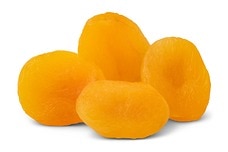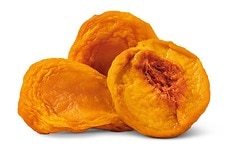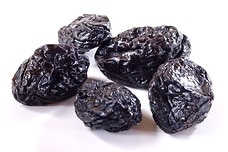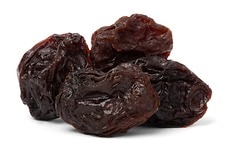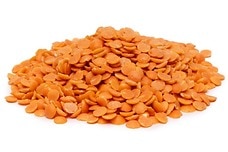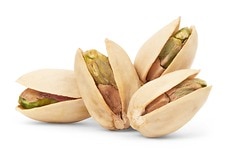Food & Snack Sources of Potassium
Potassium is one of the essential minerals necessary for maintaining good health at every age and in every stage of life. Potassium is a type of electrolyte – a substance that can break down into charged atoms called ions to facilitate electrical transmissions needed for cells to communicate with one another. Your body needs potassium to facilitate normal muscle movement, to manage the passage of fluids and other minerals into and out of your cells, and to help regulate blood pressure. Some studies indicate a balanced intake of potassium may also help reduce the risks of osteoporosis, strokes and kidney stone formation (Linus Pauling Institute [LPI], 2010; Academy of Nutrition and Dietetics, 2014).
Getting the Potassium you Need
Potassium is essential for many crucial functions in the body, but are you getting enough? According to the Institutes of Medicine (IOM), the recommended dietary allowance (RDA) of potassium is 4700 mg for adolescents and adults age 14 years and up. Breastfeeding women need a little more – about 5100 mg per day (LPI, 2010; Institute of Medicine, n.d.).
Unfortunately, government data indicate less than 2 percent of adults in the U.S. get the recommended daily amounts of potassium, which means they're at risk for a whole host of medical problems associated with potassium deficiency. In fact, most adults in the U.S. get about half the recommended daily value (DV) for the mineral (Cogswell et al., 2012).
What Happens if You Don't Get Enough Potassium?
Not getting enough potassium can have serious consequences for your health. Though extremely uncommon, chronically low levels of potassium can result in a medical condition called hypokalemia. People who have hypokalemia can experience symptoms like abnormal heart rhythms, high blood pressure and muscle weakness.
While hypokalemia can affect anyone, it's more likely to occur in people who:
- Take diuretics (also referred to as “water pills”) for treatment of high blood pressure or heart failure
- Take a lot of laxatives/
- Abuse alcohol
- Have anorexia or bulimia
- Have diseases or disorders affecting the kidneys or the adrenal glands, located on top of the kidneys
- Have a prolonged period of vomiting or severe diarrhea (U.S. National Library of Medicine, 2014)
Although you can take supplements to boost your levels of potassium, supplements have been associated with gastrointestinal problems, including: belly cramps, diarrhea, vomiting and nausea, and development of a serious condition known as hyperkalemia that can cause dangerous arrhythmias. The best way to make sure you're getting enough potassium is to add some foods that are rich in potassium, including potassium-rich snacks, to your diet (LPI, 2010; Cogswell et al., 2012).
High-potassium foods
Plant-based foods are excellent sources of potassium. Some of the best ways to meet your daily target intake of potassium is to eat the following foods:
- Bananas: 422 mg potassium per medium banana
- Prune juice: 528 mg per 6-ounce serving
- Potato: 926 mg per medium potato (including skin)
- Orange juice: 372 mg per 6-ounce serving
- Prunes: 637 mg per ½ cup
- Raisins: 598 mg per ½ cup
- Lima beans: 485 mg per ½ cup
- Spinach: 420 mg per ½ cup (cooked)
- Sunflower seeds: 241 mg per ounce
Dried apricots and almonds are also sources of potassium that are easy to incorporate into a healthy snacking routine. Other sources of the mineral include sweet potatoes, oranges, tomatoes and tomato juice. But if you're looking for a top source of potassium that's easy to snack on anytime of day, look no farther than delectable, crispy banana chips.
Bananas are one of the best sources of potassium- and, unlike fresh bananas that have a limited shelf life, banana chips stay fresh for a long, long time. Plus, they don't bruise or become soft and damaged when packed in a pocket, purse or briefcase. Banana trail mixes – with or without chocolate – are tasty, crunchy and packed with nutrients, including potassium, magnesium and iron (LPI, 2010).
Dried fruits, nuts and trail mixes are powerhouses of nutrition, and because the ingredients don't need refrigeration, they're among the most convenient natural sources of vital minerals you can find. Keep some on hand at home, in your purse or briefcase, and in your desk drawer for a boost of natural nutrition you can snack on anytime and anywhere. Additionally, dehydrating fruits doesn’t damage the nutritional content of the food- but rather serves to make the pieces more calorically and nutritionally dense (Campbell, 2015).
To ensure you get enough potassium, eat a variety of fruits and vegetables every day. Consuming snacks of dried fruits or seeds is a good way to help you get enough. For specific recommendations, peruse the recipes and snack recommendations provided below.
High-Potassium Recommended Recipes
Adding potassium is easy when your favorite foods provide a rich supply in the form of a tasty treat. Check out these recipes that offer an abundance of the mineral in every serving and that are as easy to make as they are easy to eat!
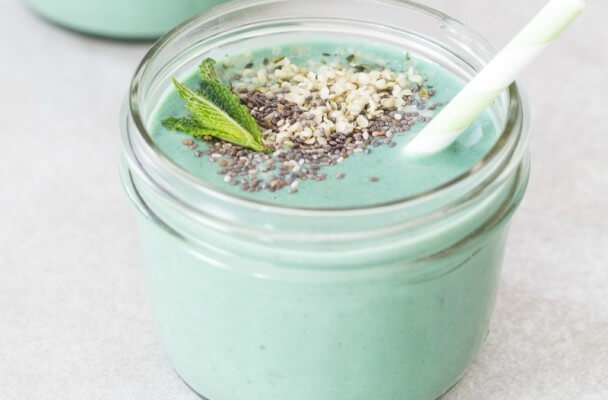
Protein-Packed Detox Smoothie Recipe {vegan}
A scrumptious source of nearly all the nutrients you need, this simple smoothie tastes great and is ideal for a post-workout snack. Add this recipe card to your collection and enjoy daily!
Ingredients: Almond milk, frozen banana, spirulina, hemp protein powder (optional), fresh mint, chia seeds, hemp hearts.
Total Time: 5 minutes
| Yield: 2 servings
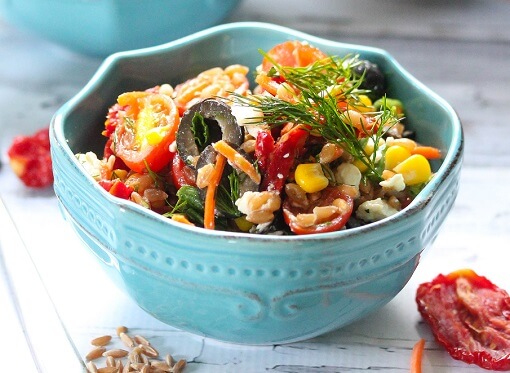
Farro Vegetable Salad Recipe
This delicious salad will soon become a staple in your household with a powerful palate that you’ll love. Each serving also supplies 22% of the Daily Value (DV) for potassium!
Ingredients: Organic farro, sun dried tomatoes, frozen corn (thawed), scallions, black olives, feta cheese, cherry tomatoes, shredded carrots, salt, fresh dill, fresh mint, extra virgin olive oil, balsamic vinegar.
Total Time: 1 hour
| Yield: 6 servings
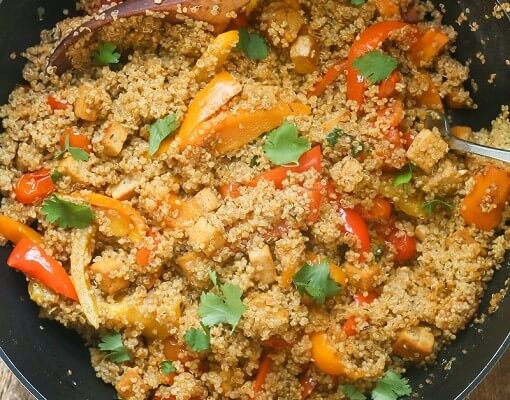
Veggie Quinoa Casserole Recipe {gluten-free, vegan}
Searching for a hearty meal that is totally free of both gluten and animal products? This incredible recipe offers all these in an absolutely scrumptious plate that you’re sure to love!
Ingredients: Quinoa, extra firm tofu, bell peppers, cherry tomatoes, olive oil, paprika, cumin, oregano, thyme, salt.
Total Time: 35 minutes
| Yield: 4 - 5 servings
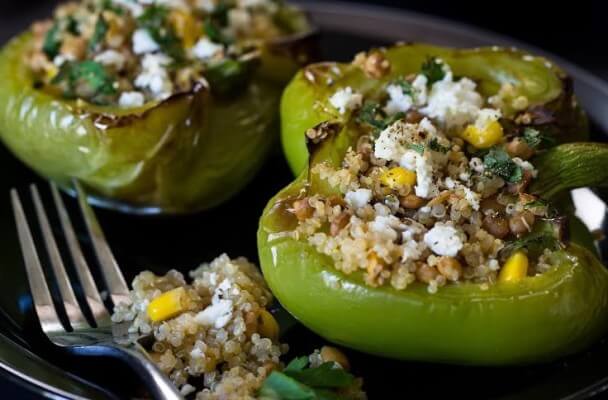
Quinoa Stuffed Peppers Recipe {gluten-free}
A mouthwatering meal that can be enjoyed as a main course or a hearty selection at parties, this dish supplies a whopping 1278 mg of potassium per serving, accounting for 29% of the DV!
Ingredients: Quinoa, green bell peppers, canned lentils, fresh spinach, feta cheese, frozen corn (thawed), salt, black pepper.
Total Time: 40 minutes
| Yield: 6 servings (8 half-peppers)
Recommended Snacks Packed with Potassium
Including a wide variety of leafy greens, citrus fruits, grapes, berries, and root vegetables can help your body get the potassium it needs every day. Check out this list of potassium-rich snacks and foods selected by our Health Nut and Registered Dietitian:
Healthy Eating
- Healthy Highlights
- 5 Uses for Cacao Powder
- 5 Ways to Eat Farro
- 6 Best Gluten-Free Foods
- Alcohol and the Body
- Almond Flour Recipes
- Anti-Aging Superfoods
- Beat the Afternoon Slump
- Benefits of a Plant-Based Diet
- Benefits of Baobab
- Benefits of Cashews
- Benefits of Coconut Oil for Hair
- Benefits of Coconuts
- Benefits of Dates
- Benefits of Fenugreek
- Benefits of Garcinia Cambogia
- Benefits of Goji Berries
- Benefits of Kale Chips
- Benefits of Monk Fruit Sweetener
- Benefits of Peanuts
- Benefits of Pecans
- Benefits of Pistachios
- Benefits of Pumpkin Seeds
- Benefits of Spelt Flour
- Benefits of Steel Cut Oats
- Benefits of Sunflower Seeds
- Benefits of Tiger Nuts
- Benefits of Turmeric
- Benefits of Walnuts
- Benefits of Wheatgrass
- Best Food Fads
- Cacao vs Cocoa
- Caffeine-Free Energy Foods
- Chocolate That's Good for You
- Diet vs. Exercise
- Fat Burning Foods
- Food Myths Debunked
- Foods for Bone Density
- Foods for Colon Health
- Foods for Healthy Hair
- Foods for Healthy Skin
- Foods to Help Sleep
- Foods to Reduce Stress
- Green Tea Benefits
- Healthy Baking Flours
- Heart Healthy Habits
- High Protein Health Risks
- How to Boost Your Metabolism
- How to Lose Weight While Aging
- How to Throw a Vegan BBQ
- Kaniwa vs Quinoa
- Little Health Foods
- Low-Carb: Fad or Friend?
- Making Healthier Desserts
- Mediterranean Diet Meal Plan
- Natural Beauty Products
- Nuts for Weight Loss
- Preparing Vegan Meals
- Preventing Muscle Degeneration
- Rare Superfoods
- Reduce Sugar Intake
- Save Time By Going Vegan
- Smarter Snack Swaps
- Smoothie Ingredients
- Soy Protein vs Whey Protein
- Starting a Plant-Based Diet
- Steel Cut vs Rolled Oats
- Sugar Substitutes
- Vegan Proteins
- Vegan Substitutions for Fall Recipes
- Why Go Vegan
- Healthy Meals
- Healthy Recipes
- Sports Nutrition
- Nutrition and Special Diets
- 21 Day Fix
- 5 Popular Diet Similarities
- Alkaline Diet
- Anti-Inflammatory Diet
- Calorie Counting
- Carb Cycling Diet
- Celiac Disease
- Cholesterol
- Clean Eating
- Crohn's Disease
- DASH Diet
- Detox Diet
- Diabetes
- Diabetes Diet
- Diet Pill Dangers
- Fat Burning Foods
- Gluten-free Diet
- Glycemic Index
- Heart Health
- High Blood Pressure Diet
- High Fiber Foods
- How to Eat Healthy
- How to Lower Blood Pressure
- Hypertension
- IBS Diet
- Ketogenic Diet
- Liquid Diet
- Low GI Foods
- Low-Carb Diet and Foods
- Low-Fat High-Carb Diet
- Mediterranean Diet
- Mediterranean Diet Foods
- Military Diet
- Nutrition Labels Explained
- Paleo Diet
- Raw Food Diet
- Superfoods
- Sustainable Weight Loss
- Thrive Diet
- Vegan Diet
- Vegetarian Diet
- Weight Loss Shakes
- Whole30
- Vitamins, Minerals & Nutrients

